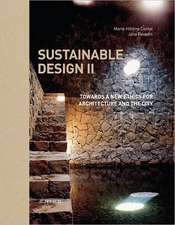The Elements of Architecture: Principles of Environmental Performance in Buildings
Autor Scott Drakeen Limba Engleză Paperback – 28 apr 2009
| Toate formatele și edițiile | Preț | Express |
|---|---|---|
| Paperback (1) | 461.57 lei 6-8 săpt. | |
| Taylor & Francis – 28 apr 2009 | 461.57 lei 6-8 săpt. | |
| Hardback (1) | 1271.75 lei 6-8 săpt. | |
| Taylor & Francis – 28 apr 2009 | 1271.75 lei 6-8 săpt. |
Preț: 461.57 lei
Nou
Puncte Express: 692
Preț estimativ în valută:
88.32€ • 94.45$ • 73.64£
88.32€ • 94.45$ • 73.64£
Carte tipărită la comandă
Livrare economică 18 aprilie-02 mai
Preluare comenzi: 021 569.72.76
Specificații
ISBN-13: 9781844077175
ISBN-10: 1844077179
Pagini: 144
Dimensiuni: 156 x 234 x 13 mm
Greutate: 0.27 kg
Ediția:1
Editura: Taylor & Francis
Colecția Routledge
Locul publicării:Oxford, United Kingdom
ISBN-10: 1844077179
Pagini: 144
Dimensiuni: 156 x 234 x 13 mm
Greutate: 0.27 kg
Ediția:1
Editura: Taylor & Francis
Colecția Routledge
Locul publicării:Oxford, United Kingdom
Cuprins
Preface Introduction: Architecture, Technology and Environment 1. Sun 2. Heat 3. Light 4. Sound 5. Air 6. Water 7. Fire 8. Ecological Design Appendices Notes Further reading Index
Notă biografică
Scott Drake is a senior lecturer in the Faculty of Architecture, Building and Planning and the University of Melbourne, Australia.
Recenzii
"At a time when environment and climate change have become sky-high on the architectural agenda, this book is a very welcome addition to the literature. Scott Drake writes with admirable clarity and focus, communicating scientific principles in a simple and accessible way." Jeremy Myerson, Helen Hamlyn Professor of Design, Royal College of Art, London
"Scott in a simple language clearly describes the ways that our buildings act as both an interface and modifier of our environment, whilst also never losing sight of the role of architecture in giving form and meaning to the synthesis of the different elements. The book is far more than a primer on building environmental performance; it describes the building function as environmental modifier in the wider role as an expression of meaning. The Elements of Architecture is insightful for all of us, as concerned citizens, in our struggle to understand better the intricate network of relationships which form our environment." John Worthington, Founder DEGW, Graham Willis Professorship in Architecture, the University of Sheffield, and Professorial Fellow, University of Melbourne
"The book is ideal for use by undergraduate architecture students undertaking architectural technology, science or design courses and for anyone interested in the environmental aspects of the buildings in which we live." Architectural Science Review
"Very interesting...excellent value to undergraduate architecture students ...highly recommended." James W Froggatt, Building Engineer, March 2010
"A very good elementary text book in the architectural curriculum." Built Environment
"His use of language is inspiring, sensitive, primitive, technical, serious and humorous at the same time […]The book has all the ingredients to draw a first year student of architecture to the potential of nature (and climate) in making every building design a cause for celebration, with both joy and real knowledge and understanding." Manjusha Misra, Iran. International Journal of Environmental Studies
"Scott in a simple language clearly describes the ways that our buildings act as both an interface and modifier of our environment, whilst also never losing sight of the role of architecture in giving form and meaning to the synthesis of the different elements. The book is far more than a primer on building environmental performance; it describes the building function as environmental modifier in the wider role as an expression of meaning. The Elements of Architecture is insightful for all of us, as concerned citizens, in our struggle to understand better the intricate network of relationships which form our environment." John Worthington, Founder DEGW, Graham Willis Professorship in Architecture, the University of Sheffield, and Professorial Fellow, University of Melbourne
"The book is ideal for use by undergraduate architecture students undertaking architectural technology, science or design courses and for anyone interested in the environmental aspects of the buildings in which we live." Architectural Science Review
"Very interesting...excellent value to undergraduate architecture students ...highly recommended." James W Froggatt, Building Engineer, March 2010
"A very good elementary text book in the architectural curriculum." Built Environment
"His use of language is inspiring, sensitive, primitive, technical, serious and humorous at the same time […]The book has all the ingredients to draw a first year student of architecture to the potential of nature (and climate) in making every building design a cause for celebration, with both joy and real knowledge and understanding." Manjusha Misra, Iran. International Journal of Environmental Studies
Descriere
The Elements of Architecture is a clear and well structured introduction to sustainable architecture, which concentrates on general principles to make an accessible and comprehensive primer for undergraduate students. The author takes a fresh and logical approach, focusing on the way aspects of the built environment are experienced by the occupants and how that experience is interpreted in architectural design. He works through basic elements and senses (sun; heat; light; sound; air; water and fire) to explain and frame effective environmental architectural design - not only arguing that the buildings we inhabit should be viewed as extensions of our bodies that interact with and protect us from these elements, but also using this analogy to explain complex ideas in an accessible manner.







